6.4 Refraction, Reflection, and Absorption
8 min read•june 18, 2024
Daniella Garcia-Loos
S
Saarah Hasan
AP Physics 2 🧲
61 resourcesSee Units
Refraction, Reflection, and Absorption
When light travels from one medium to another, some of it is transmitted, some is reflected, and some is absorbed.
Reflection—The light bounces off the surface; the reflection of light on a mirrored surface results in the formation of an image.

Taken from pxhere.com
Absorption—The light is converted to another form of energy, usually heat (the light disappears as it enters another medium).
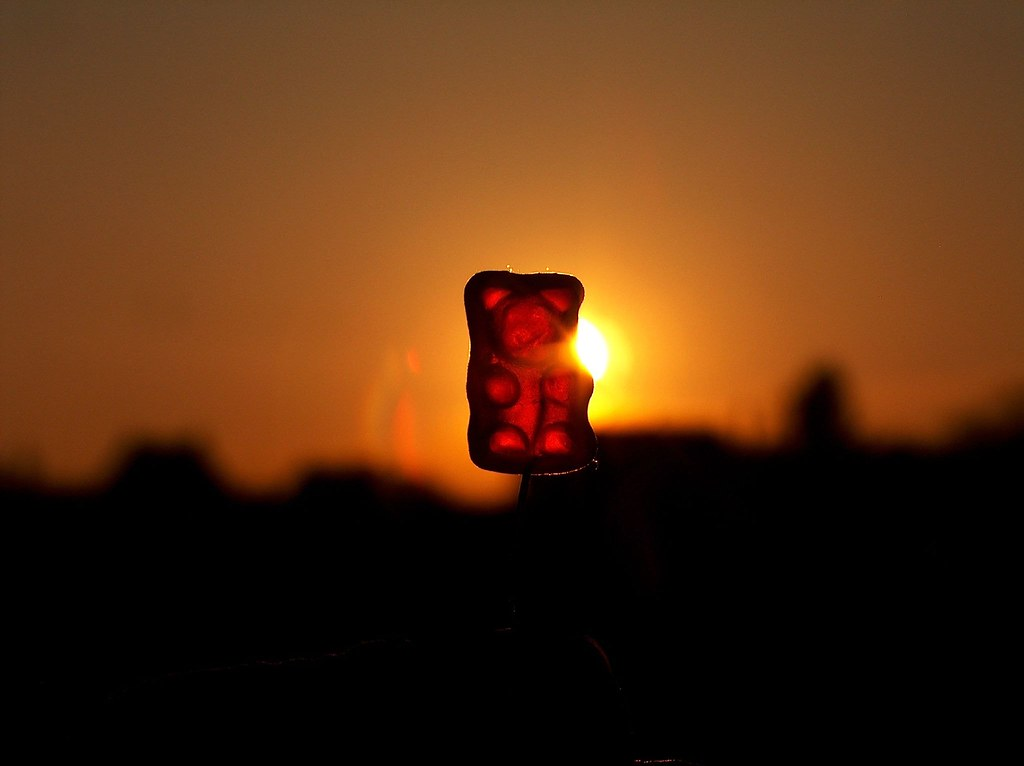
Taken from flickr
Transmission—The light goes right through one medium to another.
Okay, so that was a super brief explanation. Let’s get a bit more in-depth. 🧐
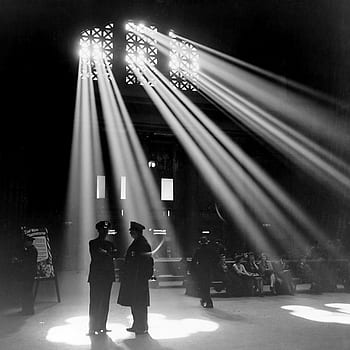
Taken from Wikipedia
Reflection and Refraction
Like we mentioned before, light has the ability to seemingly bounce (or reflect) off of a surface. There are two kinds of reflections: specular and diffuse.
Specular—reflections off of a smooth surface; the orientation of the incoming light rays are preserved
Diffuse—reflections off of a rough/uneven surface; the incoming light rays are scattered in different directions.
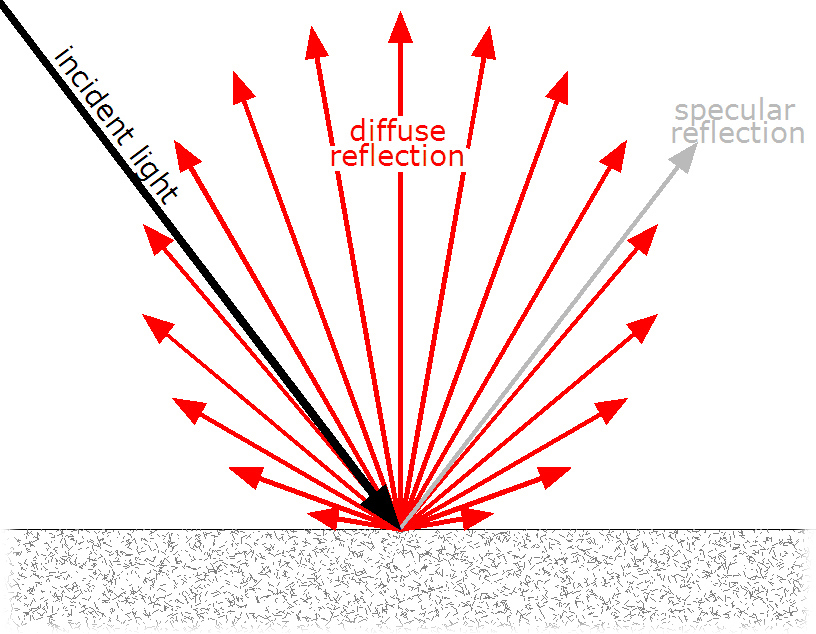
Taken from Wikimedia Commons
When light hits a smooth, reflecting surface (specular reflection), it reflects at the same angle on the other side of the line perpendicular to the surface.

Taken from Wikimedia Commons
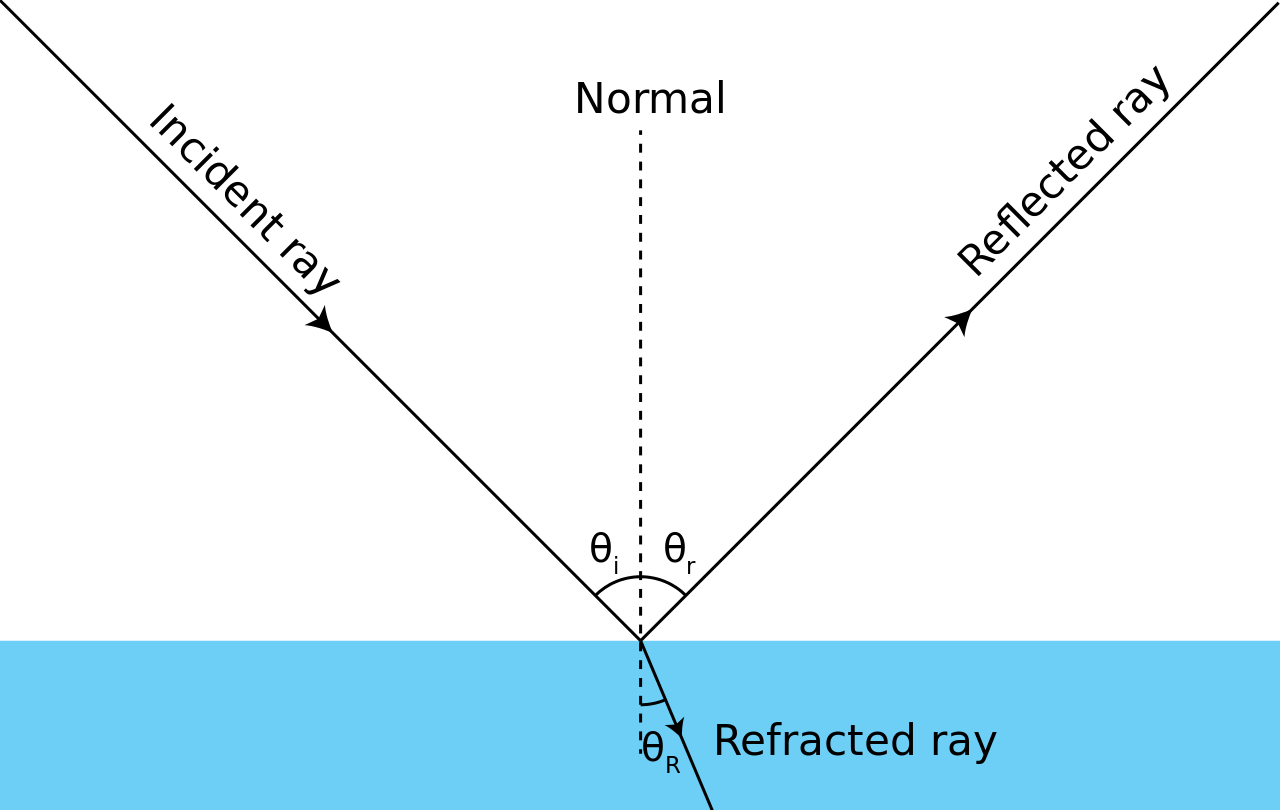
Taken from Wikipedia
In the image above, the light ray approaching the boundary of another medium is the incident ray, and the light ray leaving it is the reflected ray. At the point where the light ray hits the boundary (the point of incidence), a line perpendicular to the surface can be drawn. This line is known as the normal line, and it divides the angle between the incident ray and reflected ray into two equal angles. The ray that passes through into the new medium is known as the refracted (or transmitted) ray.
The angle between the incident ray and the normal line is the angle of incidence, the angle between the reflected ray and the normal line is the angle of reflection, and lastly, the angle between the refracted ray and the normal line is the angle of refraction.
The law of reflection states that the angle of incidence (θi) is equal to the angle of reflection(θr).
θi=θr
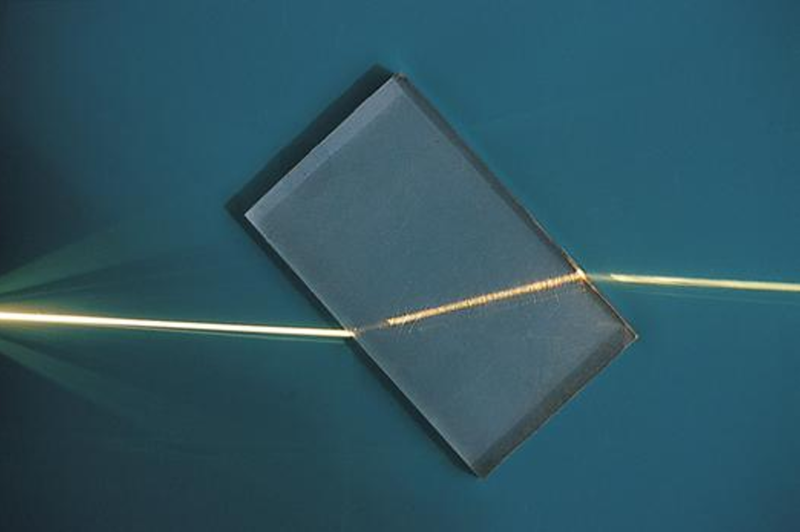
Taken from Wikipedia
Let's expand on the refraction of light. (Here's an interactive.)
Just as we mentioned in 6.1, wave speed depends on the medium. When light rays change speed as they travel from one medium to another, the light appears to bend. Refraction is essentially this "bending". However, if there's no change in speed or if the angle of incidence is zero as the light passes from medium to medium, there'll be no refraction.
When light travels from one medium to another and slows down (the angle of refraction is less than the angle of incidence), the light is been refracted towards the normal. When light travels from one medium to another and speeds up (the angle of refraction is larger than the angle of incidence), the light is been refracted away from the normal.
One thing to keep in mind: when light refracts, its frequency doesn't change.
When light travels through a material medium, it gets absorbed and re-emitted, which causes its apparent speed v, to be some fraction of c=3.00 * 10⁸ the speed of light traveling through empty space/vacuum). The reciprocal of this fraction, which essentially describe how fast light travels through the material, is the medium’s index of refraction:
n=c/v
Some things to remember about the index of refraction:
- n has no units.
- It’s never less than 1, since light always travels slower in a medium than in a vacuum.
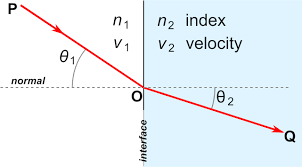
Taken from Wikipedia
The equation that relates the angle of incidence and angle of refraction involves the index of refraction of the incident medium (n₁) and the index of refraction of the refracting medium (n₂) and is called Snell’s Law:
n₁sinθ₁=n₂sinθ₂
- If n₂>n₁, θ₂<θ₁ - the ray will refract toward the normal
- If n₂<n₁, θ₂>θ₁ - the ray will refract away from the normal
Here are some key points about Snell's law:
- Snell's law is a fundamental principle in optics and is used to understand and analyze the behavior of light in different media and to predict the behavior of optical devices and systems. It is a useful tool for designing and troubleshooting optical systems and devices.
- Snell's law is based on the principle that the ratio of the sines of the angles of incidence and refraction is equal to the ratio of the refractive indices of the media. This relationship is described by the equation n₁sinθ₁ = n₂sinθ₂, where n₁ and n₂ are the refractive indices of the media, and θ₁ and θ₂ are the angles of incidence and refraction, respectively.
- Snell's law is a consequence of the wave nature of light and the fact that light can be reflected and refracted at boundaries between media. It is based on the observation that light is refracted at a certain angle when it is incident on a boundary between two media with different refractive indices.
- Snell's law is used to predict the angle of refraction of light when it is incident on a boundary between two media with different refractive indices. It is also used to understand and analyze the behavior of light in different media and to predict the behavior of optical devices and systems.
Total Internal Reflection
As we mentioned previously, when light is refracted from a medium with a high index of refraction to one that has a lower index of refraction, it refracts away from the normal. As the angle of incidence increases, the angle of refraction becomes larger. When the angle of incidence reaches a critical angle, θc, at which the angle of refraction equals 90 degrees, the refracted beam is directed along the surface.
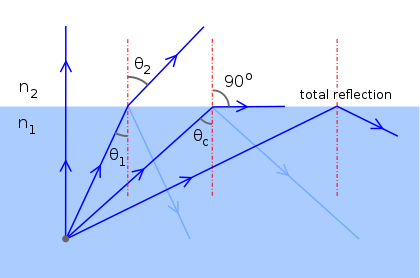
Taken from Wikimedia Commons
If the angle of incidence exceeds θc, there is no angle of refraction. The light will be reflected back into the original medium, a phenomenon called total internal reflection.
The critical angle can be found in the equation:
sinθc=n₂/n₁ (n₂<n₁)
If θ₁>θc, then total internal reflection will occur.
Total internal reflection is a phenomenon that occurs when light is incident on a boundary between two media with different refractive indices and is reflected back into the same medium. The critical angle is the angle of incidence at which total internal reflection occurs.
Here are some key points about total internal reflection and critical angles:
- Total internal reflection is a phenomenon that occurs when light is incident on a boundary between two media with different refractive indices and is reflected back into the same medium. It occurs when the angle of incidence is greater than the critical angle.
- The critical angle is the angle of incidence at which total internal reflection occurs. It is the angle at which the angle of refraction is equal to 90 degrees. The critical angle is determined by the refractive indices of the two media and is given by the equation θc = arcsin(n₂/n₁), where θc is the critical angle, n₁ is the refractive index of the first medium, and n₂ is the refractive index of the second medium.
- Total internal reflection is an important phenomenon in optics and is used in a variety of applications, such as fiber optics, microscopes, and laser systems. It is also used to understand and analyze the behavior of light in different media and to predict the behavior of optical devices and systems.
- Total internal reflection is a consequence of the wave nature of light and the fact that light can be reflected and refracted at boundaries between media. It is based on the observation that light is reflected back into the same medium when it is incident on a boundary at a certain angle.
Practice Problems 🧩
1. The critical angle of a material is the angle of incidence for which the angle of refraction is:
B) 30°
C) 45°
D) 90°
E) 180°
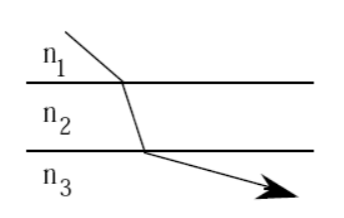
2. A beam of light passes from medium 1 to medium 2 to medium as shown in the accompanying figure. What is true about the respective indices of refraction (n₁, n₂, n₃)?
A) n₁ > n₂ > n₃
B) n₁ > n₃ > n₂
C) n₂ > n₃ > n₁
D) n₂ > n₁ > n₃
E) n₃ > n₁ > n₂
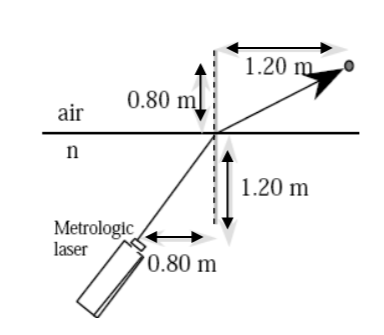
3. A laser is embedded in a material of index of refraction n. The laser beam emerges from the material and hits a target. See the accompanying figure for the position parameters of the laser and target. The value of n is:
A) 1.4
B) 1.5
C) 2.1
D) 3.5
E) 5.0
4. A wave moves from one medium to a second medium with a different index of refraction. Which of the following wave properties would NEVER change?
B) wavelength
C) speed
D) angle
E) all will change
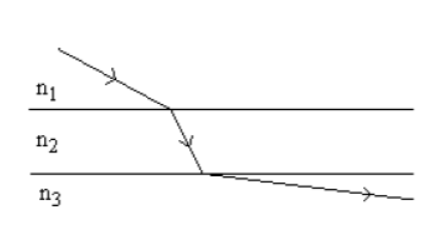
5. A beam of light passes from medium 1 to medium 2 to medium 3 as shown in the diagram. What may be concluded about the speed of light in each medium?
A) v₃ > v₁ > v₂
B) v₁ > v₂> v₃
C) v₁ > v₃ < v₂
D) v₂ > v₃ > v₁
E) v₂ > v₁ > v₃
6. Specular reflection occurs whenever light is incident on
A) a smooth surface
B) a rough surface
C) a boundary between high index of refraction and low index of refraction materials
D) a boundary between low index of refraction and high index of refraction materials
E) a boundary between any two transparent substances, regardless of index of refraction
Answers
- D: Definition of critical angle.
- D: More–Less dense bend away, Less–More dense bend towards. The more the bend, the bigger the difference in n’s.
- B: If you look carefully you can see these are both 3–4–5 triangles and are also the same triangle flipped. The hypotenuse of each is 1.5 m. Using the sides of the triangles, we have sin θ₁ = o/h = 0.8/1.5 for the bottom triangle, and sin θ₂ = o/h = 1.2/1.5 for the top triangle. Now use n₁ sin θ₁ = n₂ sin θ₂ … n₁ (0.8/1.5) = (1) (1.2/1.5) … n₁ = 1.2/0.8=3/2=1.5
- A: Fact for refraction problems
- A: More–Less dense bend away, Less–More dense bend towards. The more the bend, the bigger the difference in n’s … this shows that n₂ > n₁ > n₃. More n means less speed so v₃ > v₁ > v₂
- A: Fact about specular reflection
Browse Study Guides By Unit
💧Unit 1 – Fluids
🔥Unit 2 – Thermodynamics
⚡️Unit 3 – Electric Force, Field, & Potential
💡Unit 4 – Electric Circuits
🧲Unit 5 – Magnetism & Electromagnetic Induction
🔍Unit 6 – Geometric & Physical Optics
⚛️Unit 7 – Quantum, Atomic, & Nuclear Physics
📆Big Reviews: Finals & Exam Prep
📚Study Tools

Fiveable
Resources
© 2025 Fiveable Inc. All rights reserved.